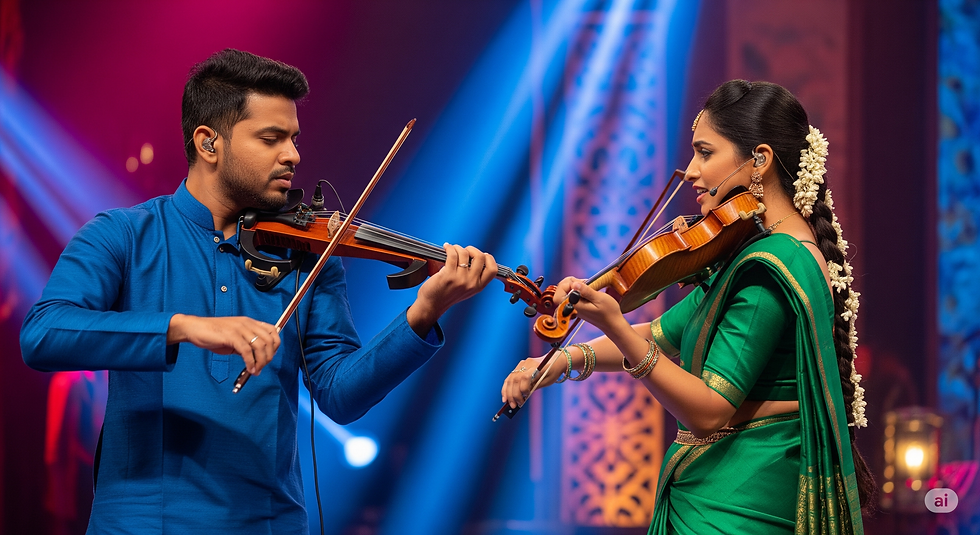"Strings of Empowerment: The Rise of Female Violinists in Carnatic Music"
- Sharanya naidu
- Aug 28, 2024
- 3 min read
Updated: Oct 16, 2024
The Carnatic music tradition, deeply rooted in South India, has long been a domain where gender roles are both defined and challenged. Among the various instruments that accompany the human voice in this classical music form, the violin holds a place of prominence. But how has the role and representation of female violinists evolved within this rich tradition? This exploration sheds light on their journey, contributions, and the challenges they have faced in establishing their place in the world of Carnatic music.
The Violin in Carnatic Music: A Brief Overview
The violin, a relatively new addition to the Carnatic ensemble, was introduced in the late 18th century. Despite its Western origins, it has seamlessly integrated into the Carnatic tradition, adapting to the complex nuances of Indian ragas and gamakas. Today, the violin is an indispensable part of Carnatic concerts, often used as an accompaniment to the main vocalist or as a solo instrument.
The Early Years: A Male-Dominated Sphere
In the early years of the violin’s incorporation into Carnatic music, the field was overwhelmingly male-dominated. The social norms and cultural expectations of the time often restricted women’s participation in public performances, and this was no different in the realm of instrumental music. While female vocalists like M.S. Subbulakshmi and D.K. Pattammal were making strides, female instrumentalists, especially violinists, were few and far between.
Breaking Barriers: The Pioneering Women
Despite these challenges, several women have made significant contributions to the Carnatic violin tradition, breaking gender barriers and setting new standards of excellence. One of the most notable figures is Dwaram V. S. Narasimha Rao, who is often credited with being a pioneering female violinist in Carnatic music. Her technical brilliance and emotive playing set the stage for future generations of female violinists.
Another trailblazer was A. Kanyakumari, whose mastery of the instrument and innovative approach to violin playing earned her widespread acclaim. Kanyakumari’s ability to blend tradition with creativity has not only enriched the Carnatic music tradition but also inspired countless young women to take up the violin as a serious pursuit.
The Evolution of Representation
Over the decades, the representation of female violinists in Carnatic music has gradually improved. The increasing number of women pursuing careers in music, coupled with societal changes that have broadened opportunities for women, has contributed to this shift. Today, female violinists are not just accompanists; many are leading performers in their own right, commanding the stage with their expertise and artistic expression.

Challenges and Opportunities
Despite the progress, female violinists in Carnatic music continue to face challenges. Gender bias, though less overt, still exists in various forms. For instance, the preference for male accompanists in high-profile concerts and the underrepresentation of women in leadership roles within music institutions are issues that need to be addressed. Additionally, the balancing act between personal life, societal expectations, and a demanding musical career can be particularly strenuous for women.
However, these challenges have also given rise to opportunities for female violinists to advocate for greater gender equality within the music community. The growing visibility of female musicians in concert platforms, music festivals, and academic circles is a positive sign of change. Moreover, the support networks among women musicians and the increasing number of female mentors in the field are helping to nurture the next generation of female violinists.
The Future: A Balanced Tradition
As we look to the future, the role and representation of female violinists in Carnatic music are likely to continue evolving. The path paved by pioneers like Dwaram V. S. Narasimha Rao and A. Kanyakumari serves as an inspiration for young women aspiring to make their mark in the world of Carnatic music. With continued efforts to promote gender equality, the tradition of the Carnatic violin can become more inclusive, reflecting a balance that honors both artistic excellence and the diverse voices that contribute to its rich heritage.
In conclusion, the journey of female violinists in Carnatic music is a testament to the resilience and creativity of women in the face of challenges. Their contributions have not only enriched the tradition but have also redefined the role of women in classical music. As music learners, understanding and appreciating this history is essential, not just for the sake of knowledge, but also to recognize the importance of gender inclusivity in the continued growth and evolution of Carnatic music.
For personalized 1:1 violin lessons with top instructors, message us on WhatsApp.



Comments